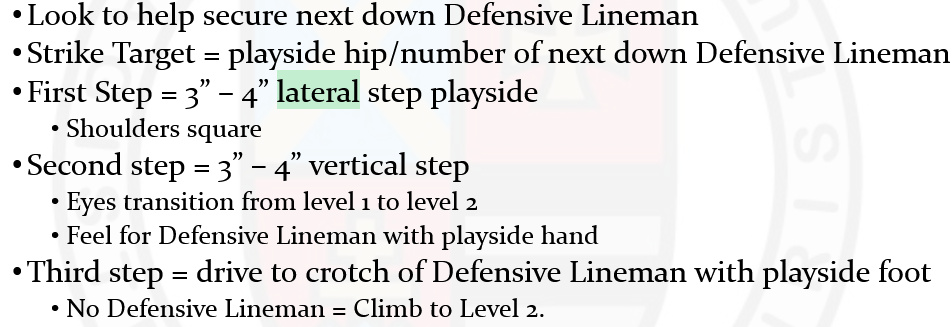Andrean High School Football Run Game Concepts
1/64
There's no tags or description
Looks like no tags are added yet.
Name | Mastery | Learn | Test | Matching | Spaced |
|---|
No study sessions yet.
65 Terms
Inside Zone
A run play targeting the interior line.
Gap-Scheme Variations
Includes Power, Counter, Trap, Power Read.
Offensive Line Splits
Distance between linemen, 2-4 feet apart.
Pilot
Closest lineman to playside in combo block.
Wingman
Farthest lineman from playside in combo block.
Double-Teams
Two linemen blocking one defender together.
Level 1 Defenders
First line of defense to be secured.
Level 2 Defenders
Secondary defenders targeted after Level 1.
Base/Drive Block
Technique to secure Level 1 defender.
Executing a Power Zone Step: Secure Level 1

Strike Target
Point of contact on defender's body.
First Step Technique
Initial movement to outside hip of defender.
Climb to Level 2
Move to next level if no defender present.
Split Zone
Wing/Running Back kicks out the EMLOS.
Wrap
Running Back blocks first Inside Linebacker.
Island Call
Backside lineman switches blocking responsibility.
Finish Every Block
Complete the block until the play ends.
Shoulders Square
Maintain alignment to effectively block defender.
Eyes Transition
Focus shifts from Level 1 to Level 2.
Combo Block
Two linemen working together on a defender.
YOU Call
Signal for Wingman to engage linebacker.
Inside Zone Variations
Different strategies within the inside zone running play.
Zone Bluff
Fake block to confuse the defense, termed 'Whiff'.
Iso
Isolation play targeting a linebacker with H-back.
Read Key
Player identified by quarterback for reading defense.
Fold Concept
Combines power elements with inside zone plays.
Fold Tags
Designations for pullers and blockers in fold concept.
TUG
Playside tackle pulls under the guard.
GUT
Playside guard pulls outside the tackle.
GUC
Backside guard pulls front side, center blocks down.
TUB
Backside tackle pulls under the guard.
CUP
Center pulls under playside guard for nose guard.
CUB
Center pulls under backside guard for nose guard.
TEX
Tight end pulls under tackle.
Running Back Alignment
Positioning of running back for play execution.
Running Back Reads
Running back's decision-making based on linebacker position.
Plug Linebacker
First playside inside linebacker read by running back.
Gap-Scheme Overview
Offensive strategy focusing on physicality and blocking.
A-Spot
Area behind defense where wall is built.
B-Spot
Area for wrapping up to the defender.
Slam/Wham
Kickout block on C-Gap or D-Gap defender.
Power Play
Running strategy emphasizing gap control and blocking.
H/Y
Aligns behind Tackle or Tight End for blocking.
ARC Call
Backside Tackle moves to second level instead of sealing.
LONG Call
Backside Guard and H/Y switch blocking assignments.
Kick-Out Block
H-Back blocks outside defender, creating space.
EMLOS
First defender outside Playside Tackle's gap.
J Block
Block targeting inside jersey number of defender.
Blitzing C-Gap Linebacker

Pulling Guard
Backside Guard responsible for blocking inside linebacker.
Frontside Window
Area for Pulling Guard to focus on blocking.
Lead Block
Blocking technique for playside H-Back or Tackle.
GT Counter
Blocking scheme involving playside and backside guards.
Tailback Path
Tailback's footwork adjusts based on backfield alignment.
Wrap Block
Block that requires staying tight to the defender.
Trap Block
Blocking technique to deceive defenders using misdirection.
Power Option
Offensive play reading first defender outside EMLOS.
Reading Defenders
Identifying key defenders based on offensive scheme.
Backside Defender
Defender opposite the direction of the play.
Frontside Defender
For Power READ schemes (Oregon)
Defensive Tackle
Defender aligned against the offensive guard.
Wham Block
Block targeting playside C-gap defender.
Seam Creation
Creating space for ball-carrier through blocking.
Chain of Events
Sequence of blocks leading to successful play.
Tag Calls
Specific calls indicating blocking adjustments.